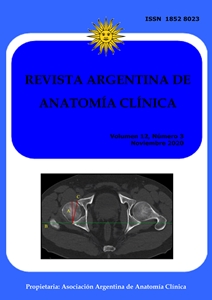TRANSFORMATION OF THE HUMAN PROSTATE GLAND IN INTERMEDIATE AND LATE FETAL PERIODS OF DEVELOPMENT
DOI:
https://doi.org/10.31051/1852.8023.v12.n3.28837Keywords:
apoptosis, glándula prostática, canalizaciónAbstract
The purpose of the study was to determinate the morphometric parameters of epithelial cords, prostatic ducts, acini of the human prostate gland and their lining epithelium, the shape of prostate glands, and muscle tissue in fetal periods of development. Material and Method: The study was performed on 19 prostate glands of male sex fetuses of intermediate and late fetal periods. We used the morphometric method of verification of apoptotic cells on stained histoligical preps using the criteria of apoptosis. Morphometric research included measurements of acini and acinar lumen areas, epithelium height, assessment of shape factors. Results: In the late fetal period compared to the intermediate fetal period the acini area was not increased in 1.1 times (p =0,004), the area of acinar lumens increases by 3.8 times (p=0.0005). Changes in the shape of acinar lumens were detected. Conclusion: An insignificant increase of the specific area of the glandular parenchyma in the organ of transformation of the developing glands occurs mainly due to their canalization. The formation of prostatic ducts was not followed by the increase in their total area and was the result of differentiation epithelial cells and apoptosis. Transformation of prostate glands in the prenatal period occurs in a certain sequence: the formation of epithelial buds, their canalization by apoptosis with formation of epithelial ducts and prostatic ducts, and formation of end pieces of prostate glands from these ducts. Apoptotic bodies were removed from the lumen of the prostatic ducts by extrusion. The design and orientation of the smooth muscle bundles around prostatic ducts and acini do not ensure the evacuation of content of the prostate glands in the fetal period.
References
Babinski MA, Chagas MA, Costa WS, Sampaio FJ. 2003. Prostatic epithelial and luminal area in the transition zone acini: morphometric analysis in normal and hyperplastic human prostate. BJU Int. 92: 592-96.
BrÖssner C, Petritsch K, Fink K, Auprich M, Madersbacher S, Adlercreutz H., Rehak P, Petritsch P. 2004. Phytoestrogen tissue levels in benign prostatic hyperplasia and prostate cancer and their association with prostatic diseases. Urol. 64: 707-11.
Bruni-Cardoso A, Carvalho HF. 2007. Dynamics of the epithelium during canalization of the rat ventral prostate. Anat. Rec. 290: 1223–32.
Сhagas MA, Babinski MA., Costa WS, Sampaio FJB. 2002. Stromal and acinar components of the transition zone in normal and hyperplastic human prostate. BJU Int 89: 699-702.
Ernst LM, Ruchelli ED, Huff DS. 2011. Color Atlas of Fetal and Neonatal Histology. New York: Springer; 414 р.
Hayward SW, Baskin LS, Haughney PC. 1996. Epithelial development in the rat ventral prostate, anterior prostate and seminal vesicle. Acta Anat. 155: 81-93.
Kolesnikov LL, Shevlyuk NN, Erofeeva LM. 2014. Terminologia Embriologica. 2nd Ed. Moscow: Geotar-Media; 417 p.
Mytsik AV. 2011. Using the ImageJ program for automatic morphometry in histological studies. Omsk Scientific Herald 2: 187-89.
Shapiro E. 1990. Embriologic development of the prostate. Insights into the etiology and treatment of benign prostatic hyperplasia. Urol Clin North Am. 17: 487-93.
Schneider CA, Rasband WS, Eliceiri KW. 2012. NIH Image to ImageJ: 25 years of image analysis. Nature Methods 9: 671-75.
Skibo YV, Abramova ZI. 2011. Methods for the study of programmed cell death. Educational and methodological manual for masters at the rate of "Theory of apoptosis" 1st Ed. Kazan: FGAOU VPO KFU; p 61.
Timms BG, Hofkamp LE. 2011. Prostate development and growth in benign prostatic hyperplasia. Differentiation 82: 173-83.
Toftgard R. 2009.Two sides to cilia in cancer. Nat Med. 15: 994-96.
Downloads
Published
Issue
Section
License
Copyright (c) 2020 Irina Piatsko, Alexander Usovich

This work is licensed under a Creative Commons Attribution-NonCommercial 4.0 International License.
Authors retain copyright and grant the journal right of first publication with the work simultaneously licensed under a Creative Commons Attribution License that allows others to share the work with an acknowledgement of the work's authorship and initial publication in this journal. Use restricted to non commercial purposes.
Once the manuscript has been accepted for publications, authors will sign a Copyright Transfer Agreement to let the “Asociación Argentina de Anatomía Clínica” (Argentine Association of Clinical Anatomy) to edit, publish and disseminate the contribution.



